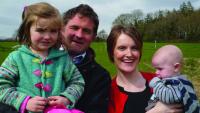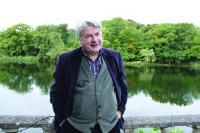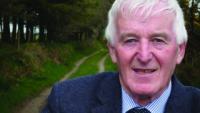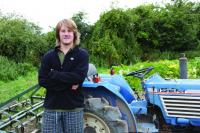The home place RTÉ 1, 9–10 May 2011 by John Gibney
Published in 20th-century / Contemporary History, Issue 4 (July/August 2011), Reviews, Volume 19
Henry and Audrey O’Grady and their two children from Clogheen, Co. Tipperary—the dairy farming that was their traditional livelihood was also a part of their identity of which they were very conscious.
According to Teagasc, a French field is likely, on average, to change hands once every 70 years. But this will only happen to an Irish field once every 555 years. It is an extraordinary statistic, one on which this assured and elegant documentary ultimately rested. Directed with great skill by the veteran Seán Ó Mordha, The home place was an engrossing meditation on the role of the farm in Irish life.
Amidst the ruins of the burst property bubble, one can occasionally find comments to the effect that a peculiarly Irish obsession with owning property was rooted in Ireland’s long experience of conquest and dispossession. It is a simplistic equation, perhaps more useful for getting unscrupulous developers off the hook than explaining the relationship between land and people. But it is this very relationship that lies at the core of Ó Mordha’s two-part series, in the form of the small family farm.

Photograph, taken by JFK himself on his first visit to Ireland in 1947, of Mary Ryan (right) and family at the ancestral homestead in Dunganstown, Co. Wexford. (Patrick Grennan)
These beautifully filmed documentaries—made without requiring either a presenter or a narration—examined the family farm as a unit at both micro and macro levels: the former in terms of the everyday business of running such an enterprise, and the latter in terms of their place in Ireland’s history and culture.
The centrality of the land was an obvious theme, and not just in a strictly utilitarian manner. For the O’Grady family of Tipperary (one of a number of farming families to feature in the programmes), the dairy farming that was their traditional livelihood was also a part of their identity of which they were very conscious. The farm had been in their family since at least the 1890s, but it could be traced back to the early eighteenth century. Even prior to this era, colonial cartographers had noted the association between the land and those who dwelt on it; the intense yet understated awareness of their hereditary occupation displayed by farmers such as Harry O’Grady and his son, Henry, was hardly a newphenomenon. Scholarship was brought to bear on such matters, and there was an obvious sensitivity at work in the choice of the ‘talking heads’ who sought to weave Irish farms into wider and deeper patterns:

Scholarship was brought to bear on matters by geographers William J. Smyth and Willie Nolan
William Smyth had done his doctoral research in the same area as the O’Gradys’ farm, and Willie Nolan had himself come from a farming background in Tipperary; his family had been evicted onto poorer uplands to make room for grazing farms. Yet it was striking that Nolan noted how the cultural injection provided by the Cromwellian settlers of an earlier era may have brought a work ethic and a certain probity thatultimately benefited all in the area.
But discussions of land ownership in Irish history are rarely so generous. According to Teagasc, the intense desire of so many Irishfarmers to hold onto what they have—maybe only 1% of Irish agricultural land comes onto the market every five years—suggested a cultural identification with their occupation and their holdings that often makes little economic sense.

Dermot Robinson, a young farmer from Bandon, Co. Cork, who also featured.(All images: Araby Productions)
Behind this lies the shadow of the struggles for land ownership that followed the Great Famine and which stretched into the first decades of independence. The breaking of the power of a landlord class whose roots could be traced back to the seventeenth century, and the wholesale transfer of Irish land into tenant ownership, constitutes the social revolution that preceded the political revolution of the early twentieth century. Yet in the 1920s, in a curious echo of the settlement of the 1660s that confirmed the existence of the Protestant landed élite in the first place, the Land Commission was established to continue to appropriate and redistribute land in order to satisfy the enduring ‘land hunger’ that still simmered throughout the revolutionary years.
Some contributors suggested a link between this lengthy historical process and the enduring conservatism often attributed to Irish farmers. But the history of Irish farming after independence saw rapid change as well as pragmatic continuity. The numbers employed in Irish agriculture decreased from c. 550,000 in 1940 to c. 300,000 in 1960. Undoubtedly, advances in technology squeezed out many opportunities for manual labour. But there was also a burgeoning awareness that there were other futures with brighter prospects than farming. Young Irish women in the 1940s and 1950s were notably unwilling to commit to the drudgery that could characterise life on a small farm; the emotionally barren vista painted in Patrick Kavanagh’s The Great Hunger reflected a cold reality. With regards to an export-driven industry largely obliged to take whatever prices it could get, Ireland’s eventual membership of the Common Market provided a welcome boost for many farmers after decades of impoverishment and hardship.
This is not to say that Irish farming had suddenly emerged into a golden age since the 1970s: farm numbers continued to drop from c. 250,000 to c. 170,000 in the course of the 1980s, as the imposition of EEC production quotas took a savage toll on smaller farms. Ó Mordha’s films give a voice to many farmers who have been at the coalface of such quiet revolutions, and who still are. Between 1999 and 2009 the average incomes of family farms dropped by a remarkable 57%; the boom years passed many of them by. This naturally poses questions about the viability of Irish farming, and its future role. One possible future might lie in a wholesale shift to a form of ‘artisan’ production, as seen in the ubiquitous farmers’ markets dotted around the country (and potentially highlighted to an overseas audience by Queen Elizabeth’s recent visit to the English Market in Cork). But the most striking aspect of Ó Mordha’s masterful films was the deep identification of so many of his subjects with what they do, and with where they and their farms had come from. Alongside this, they displayed a remarkable—and, it must be said, an admirable—determination to maintain the tradition of which they are a part in the face of economic uncertainty. It would be easy to romanticise this, were it not for the fact that in straitened times such sentimentality would surely be inappropriate, and would do a disservice to the genuine depth of feeling that bound these farmers to their farms. These lucid and unsentimental films were, undoubtedly, aptly named. HI
















